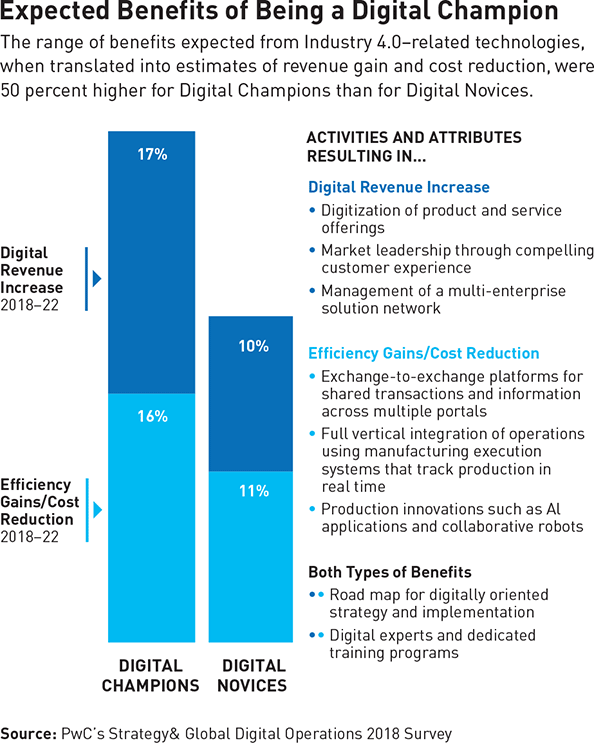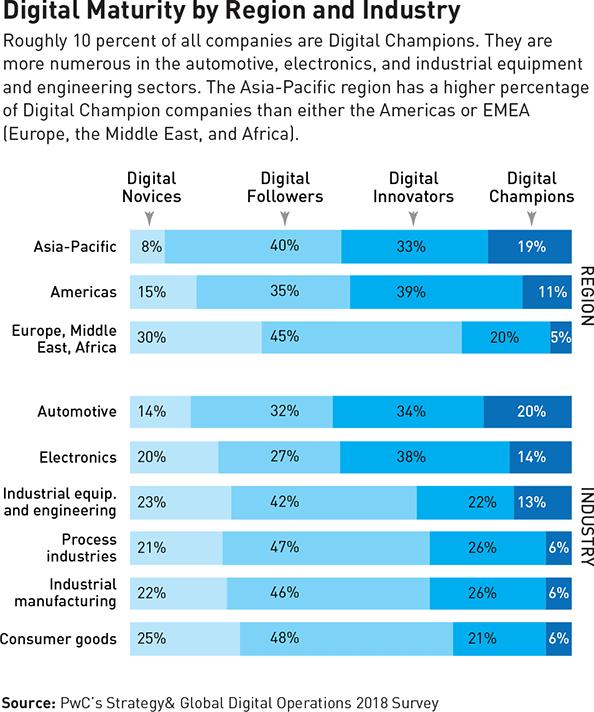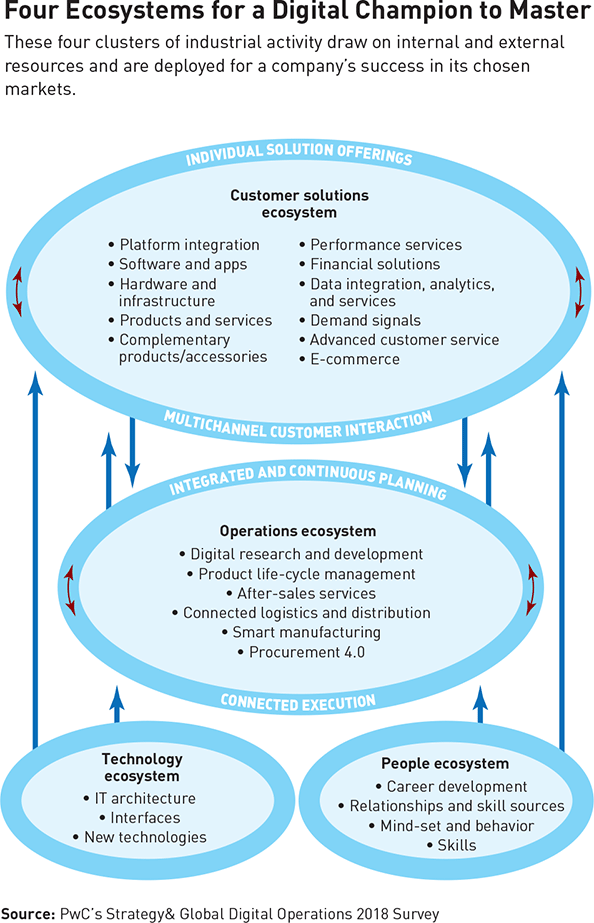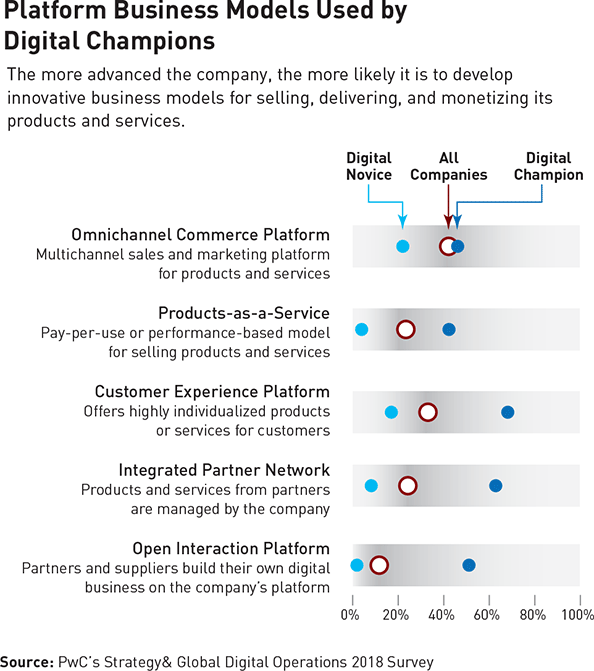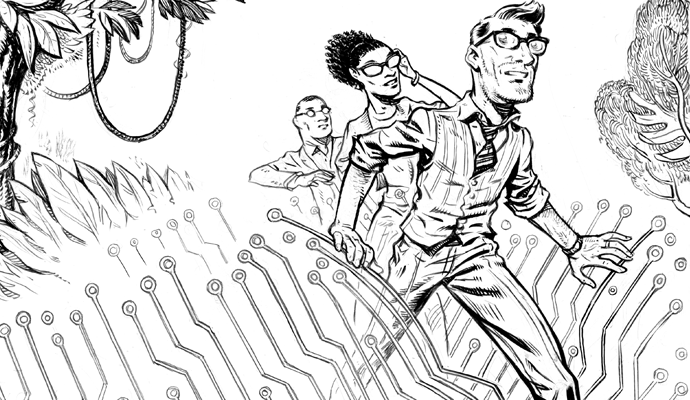Digital Champions
The interlinked platforms that make up Industry 4.0 represent a new kind of challenge for manufacturers and other technology-intensive companies. With four key business ecosystems, they can make this new world their own.

Most manufacturers, energy companies, and raw materials providers know they face a strategic challenge. Industry 4.0 is coming. Dubbed the “fourth industrial revolution” by World Economic Forum founder Klaus Schwab, this orchestrated system of digital advancement has also been referred to as an industrial renaissance (see “A Strategist’s Guide to Industry 4.0,” by Reinhard Geissbauer, Jesper Vedsø, and Stefan Schrauf, s+b, May 9, 2016). It is emerging from a number of different companies and government initiatives, most notably in Germany, the United States, and China.
In all cases, the promise is the same. The last industrial revolution (known as Industry 3.0) involved the automation of single machines and processes. This new wave of operations integrates every aspect of the value chain in one end-to-end digital platform, using sensors and analytics throughout, incorporating the Internet of Things (IoT), with cloud-based software driving the entire process. Companies can use this new shared smart infrastructure to make their manufacturing and logistics more efficient, to offer innovative products and services, and to keep improving their production on the fly, responding in unprecedented ways to customer and consumer demand.
The benefits are immense, and impressive examples of Industry 4.0 have begun to emerge. The connected industry platform at Bosch Rexroth, a global electronics and engineering company, has set a goal of realizing €1 billion (US$1.2 billion) in savings by 2020 and offering similar sensor- and software-based solutions to its customers. GE Digital, the enterprise that oversees GE’s industrial Internet platform, set a similar target in 2015, aiming to realize US$1 billion in productivity goals by 2020 — a target it reached in 2017. Daimler credits its “smart production” Industry 4.0 initiative with helping it set seven consecutive annual production records for its Mercedes-Benz cars, with all its vehicle models and drive types rolling off the same fully flexible production lines. Li & Fung, which provides logistics and supply chain services to the consumer products and apparel industries, has dramatically reduced time-to-market. For example, its apparel manufacturing clients use the company’s virtual reality environments to see how garments would look on purchasers and rapidly adjust designs. French aerospace and defense components manufacturer Safran, with its “factory of the future” initiative, is approaching growth rates for its four-year-old LEAP turbofan jet engine that the engine’s predecessor, the CFM56, never reached in 20 years of volume production.
Cases like these are noteworthy for two reasons. First, they demonstrate the advantages that manufacturers can enjoy from Industry 4.0: improved pathways for revenue and profit growth, greater customer satisfaction and loyalty, increased operational efficiency, reduced product development cycles, faster scalability, and more gainful supplier relationships (see “Expected Benefits of Being a Digital Champion”). Second, they illustrate the challenges involved in realizing those gains. Industry 4.0 is not a group of technological platforms that can easily be adopted as a purely operational upgrade. It requires a clear strategy and top management commitment; the transformation of key operational activities; and a deep understanding of collaboration, across internal company boundaries and likely with other companies that share the same platforms and technologies.
Many business-to-business enterprises claim to have already adopted this concept. Indeed, in the industrialized world, Industry 4.0 is becoming as essential as lean strategy: If you can’t claim to have mastered it, you may be out of the game. But of companies in the most relevant sectors — makers of automobiles, consumer goods, electronics, and industrial equipment, along with engineering and process industries — only about 10 percent have mastered the strategic, operational, and cultural changes necessary to make Industry 4.0 succeed. We call these companies Digital Champions. By their account, they have used the technologies of Industry 4.0 in a comprehensive way, to consistently and significantly improve their results.
We saw the power of these champions of the industrial renaissance in the last quarter of 2017, when we surveyed more than 1,100 executives at global manufacturing companies, asking them about their digital operations. By awarding points for specific digital capabilities and strategies — a maximum of 40 points for digital ecosystems, 40 points for implementation of new technologies, and 20 points for fostering a digital culture — we were able to place each company on a digital maturity scale, representing the degree to which they had implemented Industry 4.0 and related technologies.
About 22 percent of the respondents’ companies were Digital Novices, employing isolated solutions and applications at the functional or department level only. The lion’s share — 42 percent — ranked as Digital Followers. They practiced vertical integration, a hallmark of Industry 3.0, linking internal functions such as sales, manufacturing, sourcing, and engineering. About 27 percent of the companies were Digital Innovators. They connected their operations to those of external partners and customers, using integrated platforms for collaboration and information exchange. The remaining 10 percent made up the Digital Champions category (see “Digital Maturity by Region and Industry”). One measure of their success is the future orientation in their product mix; Digital Champions already generate, on average, 56 percent of their revenues from digital or digitally enhanced products and services, compared with 35 percent for Innovators, 15 percent for Followers, and only 8 percent for Novices.
Some Digital Champions are household names, among the largest and most accomplished industrial manufacturers in the world. Others are innovative middle-market companies, or startups at the edge of manufacturing practice. They use advanced technologies to raise their levels of product development, production, supply chain management, logistics, and distribution. This gives them more interactive and intimate relationships with customers. Organizationally, they seek to master four business ecosystems: customer solutions, operations, technology, and people (see “Four Ecosystems for a Digital Champion to Master”).
An ecosystem, in this context, is a cluster of vital industrial activities, some inside the organization and some outside, tied together through common digital connections and practices. Each ecosystem is connected to the others through digital pathways that foster sophisticated multifunctional capabilities. Manufacturers that hope to climb the digital maturity ladder can achieve their competitive advantage by orchestrating and integrating these four ecosystems.
Each of the ecosystems is pivotal. None can be ignored. For example, a well-designed customer solutions ecosystem, oriented to understand and respond to market conditions, represents a good first step toward a digitally mature business model. But if that company’s operations ecosystem does not have the requisite capabilities, partnerships, and technology, and does not plan to propel efficiency and effectiveness, it won’t be able to produce its goods as profitably as its Digital Champion competitors do, and its business model will fall flat. If its technology ecosystem is outmoded, or its people ecosystem is unfocused, it will similarly be unable to deliver and compete.
Each Digital Champion has its own form of Industry 4.0 prowess. Some have highly effective go-to-market strategies. Others excel at implementing a transparent and integrated supply chain, or at attracting talented people. But on the whole, Digital Champions distinguish themselves by a continuous effort to improve their capabilities in all four ecosystems and by integrating and orchestrating them.
Customer Solutions: Meeting the Market
This is the ecosystem with the greatest visibility to the outside world. Its activities include defining digitally enabled product and service offerings, attracting customers, and maintaining relationships with customers, directly or through third parties (such as retailers or online channels). In the customer solutions ecosystem, insights about retail shopping behavior and preferences are linked (with software and data analytics) to the development of products tailored directly to customers. Digital Champions tend to have broad, sprawling customer solutions ecosystems, with links to a range of external companies as well as their own internal groups, which might have been connected in only limited ways before. Now they capture and share relevant customer data, gleaning insights that allow them to develop individualized products and services and offer them through a variety of routes to market, such as third-party vendor platforms, e-commerce, retail outlets, and apps.
Only about 10 percent of the companies we surveyed have mastered the strategic, operational, and cultural changes necessary to make Industry 4.0 succeed.
These joint ventures and informal partnerships with external companies distinguish a customer solutions ecosystem from a vertical, customer-centric product development function. By adding external expertise — often from other companies with deep experience in particular niche or technology arenas — Digital Champions can fill important gaps in their go-to-market strategies. Li & Fung, based in Hong Kong, maintains an Industry 4.0–oriented platform for apparel makers around the world, drawing regularly on its participating companies for data and expertise. On its customer portal, clothing makers and retailers enter designs of new fashions. Its vendor portal hosts suppliers and contract manufacturers, which can immediately produce new collections or replenish existing lines, depending on customer demand, for their customer-facing counterparts. Li & Fung’s customer solutions ecosystem provides dense digital connections among all the companies that use these two portals, generating real-time consumer purchasing and preferences data from stores and other apparel outlets and feeding it back into the supply chain. This enables designers to change product volume and features instantly, numerous times a season. In turn, manufacturers use this data to anticipate new production runs even before they are ordered.
Another customer solutions ecosystem play is the partnership between GE’s Predix — its industrial Internet platform — and Apple. Predix apps are available for iPhones and other iOS devices, allowing industrial customers to write asset tracking and maintenance programs for their handhelds and gain operational mobility. At DuPont, the customer solutions ecosystem enabled a joint venture with Chinese equipment company Hebei Nonghaha Agricultural Machinery Group, created to develop a device that plants one corn seed per mound. General Motors developed a customer solutions ecosystem play around autonomous vehicles and self-driving cars, prototyping a number of experiments with business offerings in this domain, including alliances with ride-sharing companies such as Lyft and fostering a new set of designs oriented toward shared or autonomous vehicles.
Some Digital Champions place themselves at the hub of a customer solutions–oriented platform; all participant organizations communicate directly with the Digital Champion rather than with one another. Apple fits this category, with its huge coterie of app developers creating products and components directly for iPhones and iPads. So does John Deere, which integrates technology and designs from third-party companies into its precision agriculture equipment to help farmers measure the use and performance of water systems, seeds, pesticides, and soil enhancement products. Other companies’ platforms, such as Siemens MindSphere and GE Predix, permit their participants to collaborate more easily.
To facilitate collaborative partnerships, drawing on the widest number of companies and individuals at low cost, Digital Champions deploy open platforms with low-friction networks that make it easy for participating companies to link in their own customer solutions ecosystems. For example, they might tailor products directly to one another’s customers, cross-branding as if they were one enterprise. These applications can generate huge revenue streams and capture customer loyalty. The survey found that 50 percent of Digital Champions have already implemented open, collaborative platforms, and 68 percent offer individualized products and services through portals with enhanced customer experience. It also found that 63 percent go even further with more intricate, data-enhanced integrated partner networks (see “Platform Business Models Used by Digital Champions”).
Operations: Rapid, Relevant Response
The operations ecosystem is the workhorse for Industry 4.0 activity. It includes the day-to-day inputs and outputs that support a Digital Champion in delivering value to customers. Among its functions are the supply chain, product development, innovation, production, logistics, distribution, and post-sales customer interaction. A highly functioning operations ecosystem can create benefits that have previously eluded manufacturers. For supply chain planning and execution, it can greatly improve efficiency and product customization by adjusting the pace of production to match real-time customer demand. For research and development, it coordinates a network of internal functions, suppliers, academia, researchers, and sourcing and logistics specialists. For manufacturing, this ecosystem vertically links and automates factories (owned by the Digital Champion or contracted out) and connects the shop floor directly to supply chain and customer demand activities.
Companies with a high level of digital maturity can design their operations ecosystem to respond more rapidly and interactively to the customer solutions ecosystem. As demand changes for products or services, the operations ecosystem continually adjusts. Suppliers or factories may be needed in new regions; warehouses and parts management may require more flexibility to deliver on accelerated just-in-time schedules; and innovative logistics partners may be added. Even if much of this happens automatically, it is critical to regularly reevaluate the operations ecosystem against performance metrics and capability requirements, drawn from the customer solutions part of the business model.
The Digital Champion Bosch Rexroth has mastered the operations ecosystem for, among other product lines, its hydraulic valves used in agricultural equipment. In one of the company’s most advanced plants, in Homburg, Germany, customized orders are assigned to a manufacturing line with a special feature: Products guide themselves through the assembly stations with the help of RFID chips. The nine intelligent stations on the line recognize how the finished product has to be assembled and thus which operational steps are necessary. Displays show workers the corresponding instructions for any of the more than 200 versions of the component that is to be processed. The assembly line integrates the human, the product, and the machine in a system of flexible mass production.
An interactive cockpit oversees the Bosch Rexroth effort, tracking key performance indicators related to the manufacturing process, along with the quality of the assembly. The cockpit collects all relevant data from the connected production facilities, updates them dynamically, and makes them available in real time.
This approach allows the company to match products to customer specifications so that the products are tailored for use in particular agricultural environments, while maintaining the speed, scale, and cost efficiency of mass manufacturing.
With the launch of its Nexeed software and service portfolio for industrial Internet applications, Bosch has pooled all its Industry 4.0 activities to support customers in connecting the value chain from end to end and integrating it into an operations ecosystem. Nexeed represents an entry point into the connected factory, tailored to customers’ needs. It allows individual lines to be combined, and interconnects factories and plant networks, including their internal and external logistics. A variety of apps and software solutions support workers in their daily tasks. Relevant manufacturing data is more quickly accessible to employees through their mobile devices; this ultimately leads to greater machine availability in production. Internal transport processes and flows of goods outside the company can be seamlessly monitored and traced back. Workers are kept informed of the location, condition, and delivery time of goods. The result is increased productivity and agility, which boosts competitiveness.
With an operations ecosystem of this sort, a company can gain at least five significant benefits.
• Transparency: It has a complete end-to-end view of the value chain.
• Real-time data sharing: All the participating departments and companies can see the same information simultaneously.
• Extended collaboration: Operational links develop organically with trusted partners (such as suppliers), becoming deeper and more synergistic over time.
• Responsiveness and flexibility: Companies can respond instantly to changes in end-user demand; they can shift plans easily and execute those changes promptly.
• Connectivity: Product life-cycle management, supply chain management, and customer information are all integrated seamlessly.
We analyze how advanced a company’s operations ecosystem is in two ways. First, we assess the manufacturing process, emphasizing the degree to which production is automated and transparently connected across the company’s own plants, along with partnering manufacturers, suppliers, and logistics channels. Ideally, all of the ecosystem’s elements are exchanging data continually and acting on it in real time. This approach is so advanced that only 5 percent of the companies we interviewed, including only 33 percent of Digital Champions, had adopted it. Digital Champions score better when it comes to linking their factories with some form of integrated digital connection; almost half of them have done this, whereas most of the companies we interviewed — about two-thirds — have just selectively automated single factories.
The second way to assess operations ecosystem capabilities is by measuring supply chain integration. Digital Champions are well ahead of other companies in this respect. More than 80 percent of Digital Champions have at least near-real-time, end-to-end integrated networks with supply chain partners that offer full collaboration and visibility among the companies involved. This customer-driven supply chain lets participating companies quickly assess the impact of potential changes in demand and resolve any constraints that would hinder a rapid shift in production and distribution schedules. Among the companies surveyed, only 27 percent have reached this high level of digital supply chain mastery.
Technology: Incessant Innovation
Because the customer solutions ecosystem determines the company’s business model, and the operations ecosystem organizes its most complex capabilities, many business strategists seem to feel they have their hands full with just those two clusters. They tend to regard the technology ecosystem as being made up of more routine functions, to be delegated to service bureau–style departments. But that is a mistake. The technology ecosystem consists of activities embedded throughout the organization in every business entity, all linked together. They include established enterprise applications such as resource planning, customer relationship management, financial analytics, and cybersecurity, along with applications tailored to new platforms and revenue streams. Digital Champions gain a back-office performance edge from this ecosystem because they incorporate latest-generation technology: advances in cloud storage and collaboration, data analytics, human–machine interfaces, customer and employee experience, and hardware and software integration.
In designing and implementing this ecosystem, Digital Champions are risk takers with discipline. They insist that their business strategy should determine which technology they adopt, while continually keeping up with digital advances that have the potential to enhance strategy, particularly involving speed, flexibility, customization, and efficiency.
Rather than having a “not-invented-here” bias toward homegrown and stand-alone systems, Digital Champions readily form partnerships with outside companies, including vendors and other users of platforms, hardware, and software, to more quickly implement new digital applications without redesigning the wheel. These attributes undoubtedly play a role in their impressive track record as innovators: More than 90 percent of the Digital Champions among our survey respondents said they were planning, prototyping, or already implementing advanced technologies such as robotics, digital twins (real-time simulations of on-the-ground operations), and the industrial IoT. The comparative figures among Digital Novices were below 40 percent.
Intriguingly, Digital Innovators, the group just below Digital Champions on the digital maturity scale, foresee revenue gains of nearly 20 percent, outpacing Digital Champions. We suspect that this figure reflects the fact that Digital Champions have already enjoyed initial revenue bumps from technology investments, whereas Digital Innovators are a step behind and will probably reap these benefits over the next few years if they adopt Digital Champion strategies soon.
One company that has made its technology ecosystem a centerpiece of its business model is Austria’s Magna Steyr, which manufactures vehicles for other automakers, often when sales fluctuate and flexible manufacturing is needed. Its portfolio has included Mercedes G-Class, BMW 5 series, and the Jaguar E-PACE and I-PACE. With this product mix, Magna Steyr is the only vehicle contract manufacturer to produce the whole band of powertrain technologies — from the internal combustion engine to plug-in hybrids to pure electric vehicles. Because Magna essentially operates a dozen or so assembly schemes for different vehicles on a single line — an approach that many automakers are still struggling to perfect — the company has had to develop factories that are completely agile. Otherwise, profitability would be impossible, as some original OEMs have discovered with their low-volume models.
Magna has overcome this agility hurdle by introducing a steady stream of Industry 4.0 digital innovations, combining them to continuously upgrade the performance of its plants. Among the technologies is a digital cockpit that produces a digital twin simulation and monitors assembly-line performance for each vehicle. Adaptable robots with AI that can recognize each vehicle and determine assembly steps instantaneously guide the cars through the manufacturing lines. An in-line quality control function checks the assembly operations against real-world expectations in each step of the process so that quality isn’t weighed only at completion, when a great deal of time tends to be wasted in the auto manufacturing process. And manufacturing data analytics are adjudged by learning machines that can alter the assembly process on the basis of new conclusions culled from prior vehicle builds.
People: Culture of Competence
As the latest industrial renaissance unfolds, there will be an increasing need for skilled workers. Some will need to configure and operate complex equipment and others to program it. All will need to make quick decisions in response to shifts in product lines, designs, and input from a range of partners. Digital Champions thus invest heavily in training and on-the-job skill development. They have also succeeded in (or at least are moving toward) building a digital culture in which people throughout the hierarchy have a high level of competence. They have mastered not just the tools of Industry 4.0, but the judgment needed to deploy those tools effectively in the service of strategic business goals. They understand the ways in which their own efforts fit into the overarching goals of the customer solutions and operations ecosystems, and thus into the organization’s rapidly evolving strategy.
These facets of the business, involving recruitment, training, workplace design, incentives, and a context for collaborative effort, represent the core of the people ecosystem, which is essential to making sure that the other three ecosystems operate at peak levels. Organizations that employ their people ecosystem to the greatest benefit have traits in common in four key categories.
• Skills: Workers can handle diverse challenges. They can turn rapidly to new tasks, learning on the job. The organization has strong capabilities in data analytics, human–machine interaction, and technology-supported decision making. There are formal pathways for increasing the workforce’s digital IQ.
• Mind-set and behavior: The organization has a digital mind-set and vision; it welcomes entrepreneurship and new leadership styles; it is open to new technology; it learns from failure; it is creative, innovative, and generally curious; it embraces a nonhierarchical, “best idea counts” mentality; and it puts a premium on rapid decision making.
• Talent sources: The company relies on cross-functional teams to drive digitization and eliminate silos. These teams are highly integrated, made up of people who work for the company mixed with employees at partnering companies; with freelancers from hackathons and accelerators; and with people from digital agencies, research institutes, and universities.
• Career development: The organization supports its people ecosystem with a variety of unorthodox appraisal, incentive, and compensation schemes that reward innovative and smart digital ideas; flexible work arrangements and telecommuting when appropriate; free time to support continuous improvement of company operations; career models that reflect the value of digital expertise; and real-time employee feedback.
As the need for skilled labor increases, it will be crucial to develop new ways of acquiring talent — often individuals educated in science, technology, engineering, and math — as well as tailored training programs in digital concepts and capabilities. To some degree, this will result in higher salaries for people with the right skills; high pay provides an incentive for employees to continually refine and improve their skills throughout their career, taking advantage of Digital Champions’ strong support for lifelong learning.
Companies with effective people ecosystems embed the IT workforce into the customer solutions and operations ecosystems. This is a sharp departure from the traditional approach, in which IT is made up of a group of isolated specialists, separately owning all technology assets and delivering services, often inefficiently, to line businesses. The people ecosystem model enables the technology ecosystem to deliver IT solutions that address precisely what the business needs when it needs it. It also fosters data-driven decision making on all levels, because people understand how to incorporate sophisticated tools into their work practices.
In our survey, Digital Champions excelled at developing digital culture. Of the Champion respondents, 59 percent have invested heavily in training to upgrade staff for digital transformation; 52 percent regard failures as an accepted part of the development process (an attitude that encourages experimentation with new ideas); and 52 percent have flat hierarchies and quick decision-making processes.
Becoming a Digital Champion
The relatively small number of Digital Champions suggests how difficult it can be to master the four ecosystems, especially for an incumbent company without a digitally oriented culture. Start by moving in several directions at once: developing ecosystem-specific capabilities while driving integration across all four ecosystems. Here are six proven steps to accelerate your efforts.
1. Conduct an ecosystem assessment. This should look closely at the state of the company’s products and services, its customer satisfaction levels, its operational capabilities, the relative value of its technology, and the skills of its people. Assess each as if you were studying a competitor, which can help shine a light on your organization’s shortcomings. Consider your external challenges. How equipped are you to meet new market developments, competitors’ moves, shifting customer expectations, regulatory changes, and technological advances? Think about the art of the possible: digital strategies based not on past constraints but on new capabilities. What can you offer now that you couldn’t before, thanks to changes in technology, better understanding of consumer behavior, and opportunities for collaboration with external partners?
2. Define a vision of what the organization can become in this new world of Industry 4.0. Using the results of the first step, decide where to position your business, which value propositions to present to customers, and how to deliver your individualized products and services. What can you offer that can be tailored to individuals, or that competitors can’t match?
3. Develop an integrated operations model. It should span all four ecosystems and enable you to work effectively with external strategic partners. Focus first on the customer solutions ecosystem, identifying the best potential partners and the capabilities you will need (for example, in marketing analytics or product research and development). Determine which are already available internally, which to develop through partnerships, and whether to make or buy the rest. With these choices made, design the operations ecosystem. Then, build out your technology and people ecosystems to enable the first two ecosystems. In your design, specify the interfaces, interdependencies, connections, technology, and data links that will ensure seamless interaction among all the ecosystems.
4. Establish an ecosystem governance, investment, and decision board. This board should set priorities and key milestones, review and approve design and implementation outcomes, make investment decisions, and oversee results.
5. Continue to build out the ecosystems, starting with the strengths you already have. Design and implement ecosystem capabilities through rapid, fluid, project-based team efforts — similar to those used in agile software development. This step should include creating collaboration models for connecting and sharing operations among partners; vendors; organizations such as factories, logistics providers, or contract manufacturers; advisors; ad hoc workforces; permanent employees; and short-term and long-term relationships. These models can be implemented as prototypes and pilots, then adjusted before subsequent ecosystem elements are rolled out. After each successful rollout, link the element to relevant aspects of the other ecosystems.
6. Take full advantage of the new value chain. After the four ecosystems are in place, implement practices to make the most of the changes. These include close monitoring of the new approaches, focusing on the levels of growth, performance, productivity, and continuous improvement. As the ecosystems evolve, reinvest in the continued growth of the four ecosystems model.
These steps can represent a few years’ worth of activity in some companies. Even a Digital Champion typically has a lot of distance left to travel before the company can claim to be an Industry 4.0 leader. Indeed, only about half of the Digital Champions we surveyed said they had effective strategies for the full range of fundamental Industry 4.0–related activity. The depth of commitment required to become a Digital Champion can be daunting. But the consequent improvements in efficiency, speed, product development, creativity, customer response, and revenue show that achieving higher levels of digital maturity is worth it.
Author profiles:
- Reinhard Geissbauer is a partner with PwC Strategy& Germany, based in Munich. He is global head of the Digital Operations Impact Center and head of the digital operations EMEA leadership team.
- Stefan Schrauf is a partner with PwC Strategy& Germany, based in Düsseldorf. He is the EMEA co-lead for digital operations and lead for global digital supply chain solutions.
- Steve Pillsbury is a principal with PwC US, where he heads the PwC North America digital operations team and serves as the U.S. lead for the PwC Digital Operations Impact Center. He is based in Chicago.
- Also contributing to this article from PwC Strategy& Germany were Evelyn Lübben, principal and project lead of the study; Phillipp Bertram, principal; Judith Schneider and Farboud Cheraghi, managers; and s+b contributing editor Jeffrey Rothfeder.


